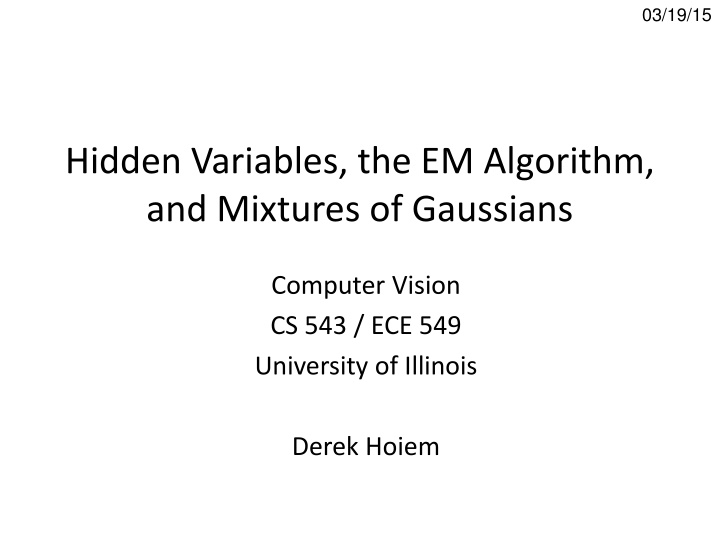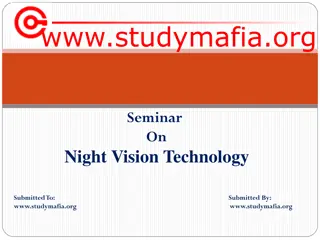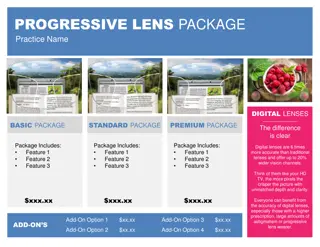
Advanced Techniques in Computer Vision: EM Algorithm and Gaussian Mixtures
Explore the intricacies of computer vision through hidden variables, the EM algorithm, and mixtures of Gaussians. Dive into examples of missing data problems and challenges such as detecting outliers, object discovery, and image segmentation without prior knowledge. Discover the nuances of maximum likelihood estimation and probabilistic inference in dealing with hidden variables.
Download Presentation

Please find below an Image/Link to download the presentation.
The content on the website is provided AS IS for your information and personal use only. It may not be sold, licensed, or shared on other websites without obtaining consent from the author. If you encounter any issues during the download, it is possible that the publisher has removed the file from their server.
You are allowed to download the files provided on this website for personal or commercial use, subject to the condition that they are used lawfully. All files are the property of their respective owners.
The content on the website is provided AS IS for your information and personal use only. It may not be sold, licensed, or shared on other websites without obtaining consent from the author.
E N D
Presentation Transcript
03/19/15 Hidden Variables, the EM Algorithm, and Mixtures of Gaussians Computer Vision CS 543 / ECE 549 University of Illinois Derek Hoiem
Final project guidelines/proposal assignment posted!
Todays Class Examples of Missing Data Problems Detecting outliers (HW 4, problem 2) Latent topic models Segmentation (HW 4, problem 3) Background Maximum Likelihood Estimation Probabilistic Inference Dealing with Hidden Variables EM algorithm, Mixture of Gaussians Hard EM
Missing Data Problems: Outliers You want to train an algorithm to predict whether a photograph is attractive. You collect annotations from Mechanical Turk. Some annotators try to give accurate ratings, but others answer randomly. Challenge: Determine which people to trust and the average rating by accurate annotators. Annotator Ratings 10 8 9 2 8 Photo: Jam343 (Flickr)
Missing Data Problems: Object Discovery You have a collection of images and have extracted regions from them. Each is represented by a histogram of visual words . Challenge: Discover frequently occurring object categories, without pre-trained appearance models. http://www.robots.ox.ac.uk/~vgg/publications/papers/russell06.pdf
Missing Data Problems: Segmentation You are given an image and want to assign foreground/background pixels. Challenge: Segment the image into figure and ground without knowing what the foreground looks like in advance. Foreground Background
Missing Data Problems: Segmentation Challenge: Segment the image into figure and ground without knowing what the foreground looks like in advance. Three steps: 1. If we had labels, how could we model the appearance of foreground and background? 2. Once we have modeled the fg/bg appearance, how do we compute the likelihood that a pixel is foreground? 3. How can we get both labels and appearance models at once? Background Foreground
Maximum Likelihood Estimation 1. If we had labels, how could we model the appearance of foreground and background? Background Foreground
Maximum Likelihood Estimation data parameters = x .. x x 1 N = x argmax ( | ) p n = argmax ( | ) p x n
Maximum Likelihood Estimation = x .. x x 1 N = x argmax ( | ) p n = argmax ( | ) p x n Gaussian Distribution 1 ) ( ) 2 x = 2 n ( | , exp p x n 2 2 2 2
Maximum Likelihood Estimation = x .. x x 1 N = x argmax ( | ) p n = argmax ( | ) p x n Gaussian Distribution ( ) 2 x 1 = 2 n ( | , ) exp p x n 2 2 2 2 1 1 n ( ) n = 2 n x = 2 n x N N
Example: MLE Parameters used to Generate fg: mu=0.6, sigma=0.1 bg: mu=0.4, sigma=0.1 im labels >> mu_fg = mean(im(labels)) mu_fg = 0.6012 >> sigma_fg = sqrt(mean((im(labels)-mu_fg).^2)) sigma_fg = 0.1007 >> mu_bg = mean(im(~labels)) mu_bg = 0.4007 >> sigma_bg = sqrt(mean((im(~labels)-mu_bg).^2)) sigma_bg = 0.1007 >> pfg = mean(labels(:));
Probabilistic Inference 2. Once we have modeled the fg/bg appearance, how do we compute the likelihood that a pixel is foreground? Background Foreground
Probabilistic Inference Compute the likelihood that a particular model generated a sample component or label = ( | , ) p z m x n n
Probabilistic Inference Compute the likelihood that a particular model generated a sample component or label ( ) = , | p z m x = , = n n m ( | ) p z m x ( ) n n | p x n
Probabilistic Inference Compute the likelihood that a particular model generated a sample component or label ( ) = , | p z m x = , = n n m ( | ) p z m x ( ) n n | p x n ( ) = | , | p z m x , = n n x m ( ) k = p z k n n k
Probabilistic Inference Compute the likelihood that a particular model generated a sample component or label ( ) = , | p z m x = , = n n m ( | ) p z m x ( ) n n | p x n ( ) = | , | p z m x , = n n x m ( ) k = p z k n n k ( ) ( ) ( k , ) = z , = | | | p x z m p z m = n n | m n m ( ) k = = p x k p z k n n n k
Example: Inference Learned Parameters fg: mu=0.6, sigma=0.1 bg: mu=0.4, sigma=0.1 im >> pfg = 0.5; >> px_fg = normpdf(im, mu_fg, sigma_fg); >> px_bg = normpdf(im, mu_bg, sigma_bg); >> pfg_x = px_fg*pfg ./ (px_fg*pfg + px_bg*(1-pfg)); p(fg | im)
Dealing with Hidden Variables 3. How can we get both labels and appearance parameters at once? Background Foreground
Mixture of Gaussians mixture component component model parameters component prior ( ) ( ) m 2 = = , , 2 | , , , | p x p x z m n n n m m m ( ( ) ( ) 2 = = = ) ( p , , 2 , | , , , | p x z m p x z m n n n n m m m ) 2 = , = | | p x z m n m m n m ( ) 2 x 1 = n m 2 exp m 2 2 2 m m
Mixture of Gaussians With enough components, can represent any probability density function Widely used as general purpose pdf estimator
Segmentation with Mixture of Gaussians Pixels come from one of several Gaussian components We don t know which pixels come from which components We don t know the parameters for the components
Simple solution 1. Initialize parameters 2. Compute the probability of each hidden variable given the current parameters 3. Compute new parameters for each model, weighted by likelihood of hidden variables 4. Repeat 2-3 until convergence
Mixture of Gaussians: Simple Solution 1. Initialize parameters 2. Compute likelihood of hidden variables for current parameters | ( n nm x m z p = = ( ) t ( ) 2 ( ) t t , , , ) n 3. Estimate new parameters for each model, weighted by likelihood 1 1 ( ) + n nm n ( ) 1 t + 2 2 ( ) 1 = t = x x + ( ) 1 t = n n n m nm n m m nm n m N nm nm
Expectation Maximization (EM) Algorithm ( ) z = x z argmax log , | p Goal: Log of sums is intractable Jensen s Inequality X E ( ) ( ) X E f f for concave functions f(x) (so we maximize the lower bound!) See here for proof: www.stanford.edu/class/cs229/notes/cs229-notes8.ps
Expectation Maximization (EM) Algorithm ( ) z = x z argmax log , | p Goal: 1. E-step: compute , | E x z ) ( p ) ( ( ) ) ( ( ) z = ( ) t x z x z z x log , | log , | | , p p ( ) t 2. M-step: solve ) ( p ) ( ( ) z ) 1 + = ( ( ) t t x z z x argmax log , | | , p
Expectation Maximization (EM) Algorithm log of expectation of P(x|z) ( ) z X E ( ) ( ) X = x z argmax log , | p E f f Goal: expectation of log of P(x|z) 1. E-step: compute , | E x z ) ( p ) ( ( ) ) ( ( ) z = ( ) t x z x z z x log , | log , | | , p p ( ) t 2. M-step: solve ) ( p ) ( ( ) z ) 1 + = ( ( ) t t x z z x argmax log , | | , p
EM for Mixture of Gaussians (by hand) ( m , | log E x z ( ) 2 2 ) x 1 ( ) m = n m 2exp 2 = = , , 2 | , , , | p x p x z m m ) ( p n n n m m m 2 ( m m ) ( ( ) ) ( ) z ( x = ( ) t x z x z z x , | log , | | , p p 1. E-step: ( ) t ) ( p ) ( ) z ) 1 + = ( ( ) t t z z x argmax log , | | , p 2. M-step:
EM for Mixture of Gaussians (by hand) ( m , | log E x z ( ) 2 2 ) x 1 ( ) m = n m 2exp 2 = = , , 2 | , , , | p x p x z m m ) ( p n n n m m m 2 ( m m ) ( ( ) ) ( ) z ( x = ( ) t x z x z z x , | log , | | , p p 1. E-step: ( ) t ) ( p ) ( ) z ) 1 + = ( ( ) t t z z x argmax log , | | , p 2. M-step: ( ) t = = ( ) 2 ( ) t t ( | , , , ) p z m x nm n n 1 1 ( ) + n nm ( ) 1 t n 2 2 = + ( ) 1 t x = x + ( ) 1 t = n n n m nm n m m nm n m N nm nm
EM Algorithm Maximizes a lower bound on the data likelihood at each iteration Each step increases the data likelihood Converges to local maximum Common tricks to derivation Find terms that sum or integrate to 1 Lagrange multiplier to deal with constraints
EM Demos Mixture of Gaussian demo Simple segmentation demo
Hard EM Same as EM except compute z* as most likely values for hidden variables K-means is an example Advantages Simpler: can be applied when cannot derive EM Sometimes works better if you want to make hard predictions at the end But Generally, pdf parameters are not as accurate as EM
Missing Data Problems: Outliers You want to train an algorithm to predict whether a photograph is attractive. You collect annotations from Mechanical Turk. Some annotators try to give accurate ratings, but others answer randomly. Challenge: Determine which people to trust and the average rating by accurate annotators. Annotator Ratings 10 8 9 2 8 Photo: Jam343 (Flickr)
HW 4, problem 2 The false scores come from a uniform distribution The true scores for each image have a Gaussian distribution Annotators are always bad or always good The good/bad label of each annotator is the missing data
Missing Data Problems: Object Discovery You have a collection of images and have extracted regions from them. Each is represented by a histogram of visual words . Challenge: Discover frequently occurring object categories, without pre-trained appearance models. http://www.robots.ox.ac.uk/~vgg/publications/papers/russell06.pdf
Next class MRFs and Graph-cut Segmentation Think about your final projects (if not done already)






















